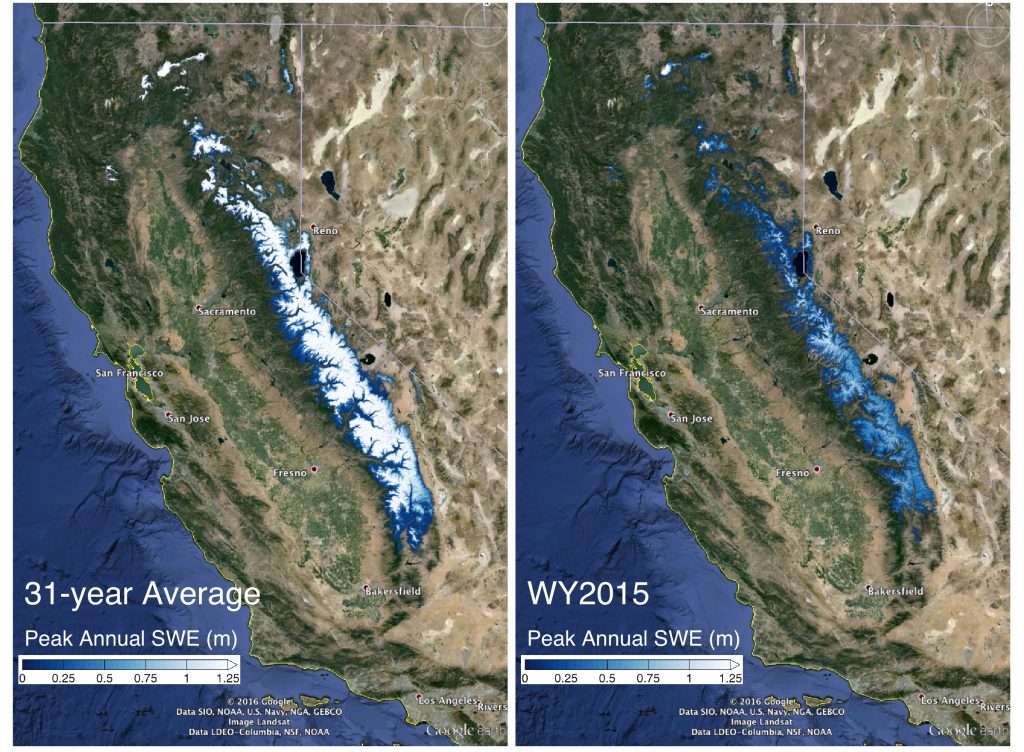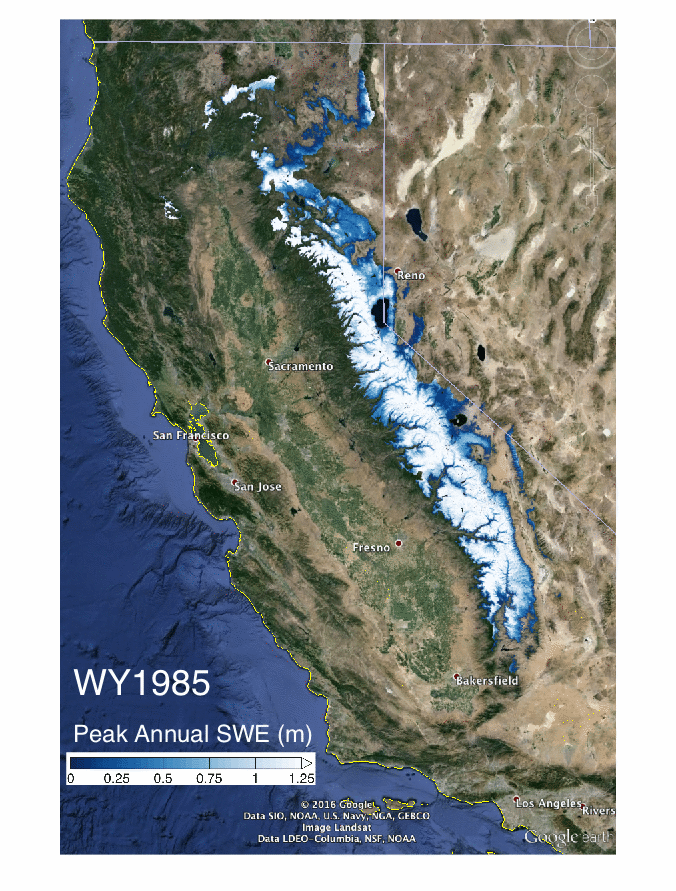21 June 2016
WASHINGTON, DC — Even with this winter’s strong El Niño, the Sierra Nevada snowpack will likely take until 2019 to return to pre-drought levels, according to new research.
Additionally, researchers suggest their new method, which provided unprecedented detail and precision, could be useful in characterizing water in the snowpack in other mountains, including ranges in western North America, the Andes or the Himalayas. These areas currently have much less on-site monitoring than in the Sierra Nevada.
The new study was published today in Geophysical Research Letters, a journal of the American Geophysical Union.

The image on the left shows the 31-year average snow water equivalent in the Sierra Nevada mountains compared with the snow water equivalent in 2015. New research shows even with this winter’s strong El Niño, the Sierra Nevada snowpack will likely take until 2019 to return to pre-drought levels.
Credit: Steve Margulis/UCLA.
“With the consecutive years of ongoing drought, the Sierra Nevada snowpack’s total water volume is in deficit and our analysis shows it will to take a few years for a complete recovery, even if there are above-average precipitation years,” said Steve Margulis, professor of civil and environmental engineering at the UCLA Henry Samueli School of Engineering and Applied Science and the study’s lead author.
Much of California’s water comes from the when the Sierra Nevada snowpack melts. The winter of 2015 capped four consecutive years of drought that resulted in the largest cumulative drought deficit spanning the 65 years that have been examined. The water volume of the snowpack in 2015 was just 2.9 cubic kilometers (0.7 cubic miles), when a typical year is about 18.6 cubic kilometers (4.46 cubic miles).
“It is critical for regions like California, that rely on their regional snowpack for water supply, to understand the dynamics of the system,” Margulis said. “Our new tool could help not just California, but other regions, gain insight about their regional snowpack.”
The researchers created a dataset covering 31 years (from 1985 to 2015), using measurements from NASA Landsat satellites, which provide daily maps of the full Sierra Nevada snowpack that have about 10 times sharper resolution than previously available. While there are on-site sensors throughout the mountain range, they are typically in the middle elevations and do not provide a full, high-resolution picture of the entire range, particularly at higher elevations, Margulis said. The researchers combined their new dataset with other snow survey data, collected by the state’s Department of Water Resources, to extend the time series of range-wide snowpack volumes back 65 years to 1951.

This animation shows the change in snow water equivalent in the Sierra Nevada mountains from 1985-2015.
Credit: Steve Margulis/UCLA.
Using the data, the researchers applied probabilistic modeling methods to make predictions of snowpack water availability. Accounting for the four-year snowpack deficit from the 2012-2015 drought, the researchers say it will likely take until 2019 to get back to pre-drought conditions.
“Our larger goal is to build a very detailed, continuous picture of the historical snowpack, diagnose the primary factors that cause it to vary, and then ultimately improve models for predicting how much water will be available from it,” Margulis said. “This unprecedented information can help policy makers make more informed decisions with regard to this critical resource, especially as climate change affects it.”
###
The American Geophysical Union is dedicated to advancing the Earth and space sciences for the benefit of humanity through its scholarly publications, conferences, and outreach programs. AGU is a not-for-profit, professional, scientific organization representing more than 60,000 members in 139 countries. Join the conversation on Facebook, Twitter, YouTube, and our other social media channels.
Notes for Journalists
This research article will be freely available for 30 days from the date of publication. A PDF copy of the article can be downloaded at the following link: http://onlinelibrary.wiley.com/doi/10.1002/2016GL068520/pdf
After 30 days, journalists and public information officers (PIOs) of educational and scientific institutions who have registered with AGU can download a PDF copy of the article from the same link.
Journalists and PIOs may order a copy of the final paper by emailing a request to Lauren Lipuma at [email protected]
Please provide your name, the name of your publication, and your phone number.
Neither the paper nor this press release is under embargo.
“Characterizing the Extreme 2015 Snowpack Deficit in the Sierra Nevada (USA) and the Implications for Drought Recovery”
Authors:
Steven A. Margulis, Gonzalo Cortés, Laurie S. Huning: Department of Civil and Environmental Engineering, University of California, Los Angeles, California, U.S.A.;
Manuela Girotto: NASA Goddard Space Flight Center, Greenbelt, Maryland, U.S.A., and GESTAR, Universities Space Research Association, Columbia, Maryland, U.S.A.;
Dongyue Li, Michael Durand: School of Earth Sciences and Byrd Polar & Climate Research Center, The Ohio State University, Columbus, Ohia, U.S.A.
Contact Information for the Authors:
Steven A. Margulis: +1 (310) 267-5490, [email protected]
Lauren Lipuma
+1 (202) 777-7396
[email protected]
UCLA Contact:
Matthew Chin
+1 (310) 206-0680
[email protected]